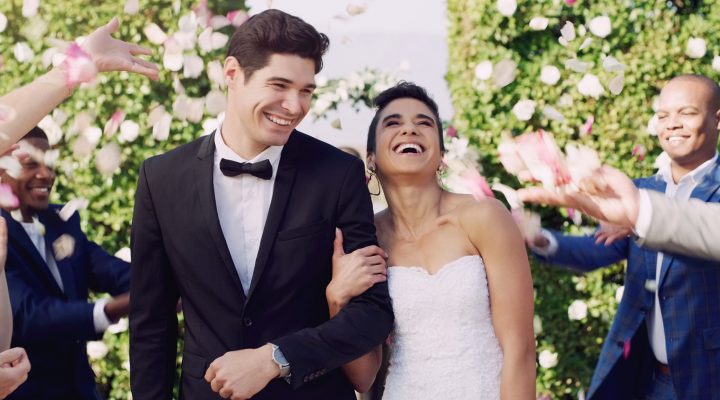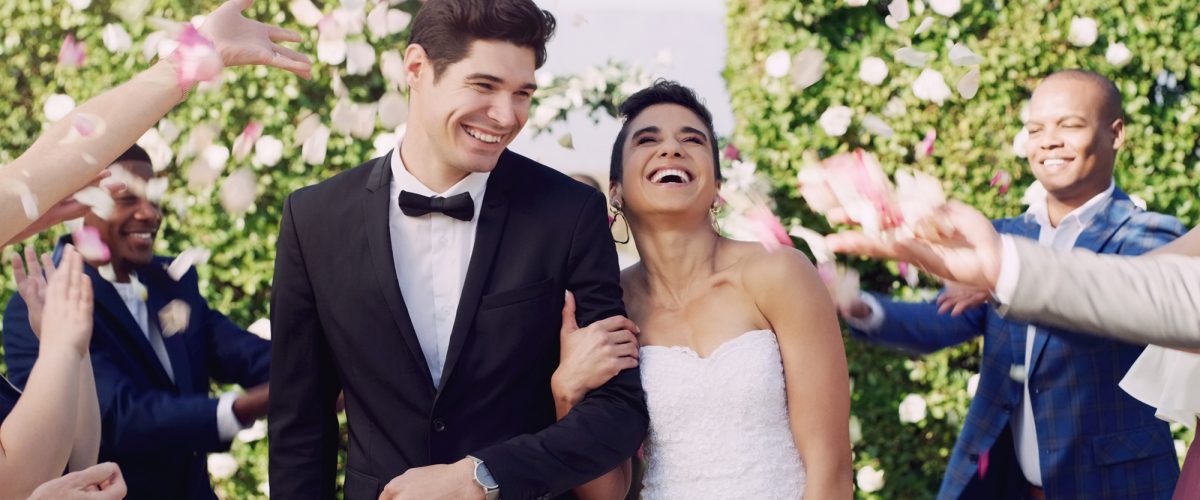Thirty-eight years ago this summer, Alison and I said “I do” in a wedding ceremony at our home church in Albuquerque. We splurged and hired trumpeters for the simple ceremony.
The crowd of 150 friends and family celebrated with us at a reception in the church’s Fellowship Hall — the kind with shuffleboard patterns embedded in the tile floor — where we served cake and punch and some other light snacks as was the custom of the day. We thought we were trendy, once again, because Alison’s father hired a barbershop quartet to roam the reception as it spilled out of the Fellowship Hall into the courtyard between there and the Sanctuary.
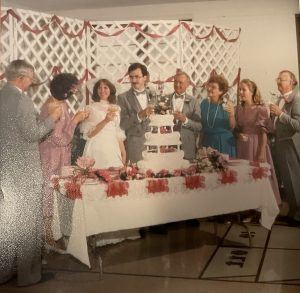
1985 wedding reception for Alison and Mark Wingfield in church Fellowship Hall. Note the shuffleboard pattern in the tile flooring.
Ours was a typical 1985 wedding in a Baptist church. All our friends who got married had similar ceremonies — minus the trumpeters and quartet, I’m sure. In fact, I can remember only one time attending a wedding for one of our peers that included a sit-down dinner for all the guests.
Thirty years later, the two children born of our marriage have become professional musicians playing hundreds of weddings with a high-end cover band. One of our sons, who is a trumpet player, estimates he’s played at about 1,000 weddings through the years.
One of those fetes was a destination wedding at a resort in the Swiss Alps (all the participants lived in the U.S.). Another was a $900,000 event in Aspen, Colo. Paying for the 20-piece live band traveling from Dallas was likely one of the smaller expenses of that wedding.
Both our sons have wild stories to tell from the weddings they’ve played, as do I for the weddings I’ve officiated as a minister.
The big difference when we swap stories is that they’ve had a lot more work as wedding musicians than I’ve ever had as a minister officiating weddings.
The wedding culture our sons work in is so different than the wedding culture of their parents’ era as to be almost unrecognizable. But this is not just our family’s story; this is the story of American weddings as a whole.
Over the past two decades in particular, American wedding norms have shifted dramatically, as documented in article after article with headlines such as “Why are Weddings So Expensive Today?” and “Should We Have a Destination Wedding?”
Here are the major shifts that have transformed weddings in America:
Fewer wedding ceremonies are held in churches
This is a trend most pastors and church administrators know all too well. The large Dallas church I’ve attended for 24 years and served as associate pastor for nearly 17 years exemplifies this trend.
Thirty years ago, our stately Georgian sanctuary and smaller chapel were the site of at least one and sometimes two weddings nearly every weekend. From the early 2000s forward, those ceremonies trickled off, to the point that prior to the pandemic, we sometimes booked fewer than five weddings a year.

(123rf.com)
Alan Rudnick, senior minister at DeWitt Community Church in Syracuse, N.Y., reports a similar trend there: “We used to do 30 to 40 weddings a year in 2015. By 2019, it was 20. In 2023, we have six on the calendar.”
Only a few churches have survived as their own kind of destination wedding venues because they are the right size, have a center aisle and are photogenic. But almost none of these church weddings are followed by cake-and-punch receptions. Guests leave the church after the brief ceremony and travel to banquet venues.
The wedding planning website The Knot reports of 2022: “For the first time, farms/barns are the top reception type — tied with banquet halls.” The article includes a chart showing the top five wedding venues in America today, and “churches” do not make the list.
“It seems like in Kentucky, they’re all taking place in a barn nowadays,” quipped Nibby Priest of Henderson, Ky.
Catherine Allen of Birmingham, Ala., has a traditional mindset about weddings: “Why are people choosing to marry in barns and improvised outdoor venues instead of churches? I hate to see $10,000 wedding gowns dragged through sand, hay and mud, with guests sweating on shaky folding chairs. Even for their own members, churches seem to be driving wedding parties out of their facilities rather than welcoming them to a helpful ministry.”

(123rf.com)
Even for the small percentage of weddings still solemnized inside a church, the reception almost always is held somewhere else. One major reason: Alcohol. The typical wedding reception today is a boozy affair, and most Protestant churches do not allow alcohol to be served on property.
Jill Granberry is the mother of two high school students — one girl and one boy — in suburban Dallas. “How did weddings become a billion-dollar industry?” she wonders.
In her generation of weddings 20 or so years ago, the trend was for couples to get married at a church and then have a reception somewhere else: “In the 1990s and 2000s, friends were marrying in church, and everybody had to travel for the reception. Venues realized they could create a one-stop event, and couples stopped getting married in the church.”
“One of the hottest trends in the wedding industry over the past two decades has been the rise of the all-inclusive wedding venue.”
Indeed, one of the hottest trends in the wedding industry over the past two decades has been the rise of the all-inclusive wedding venue. These are barns, chapels, gardens, museums and banquet halls that cater exclusively to weddings.
For one price, these sites offer a venue for the ceremony that is adjacent to or transforms into a reception venue. The packages often include everything from a wedding coordinator to on-site catering and floral services, as well as options on alcohol.
Chad Mustain is a Dallas minister and chaplain who officiates about 15 weddings every year and has done so for a decade.
“I have yet to perform a wedding in a church,” he said. “Many churches and communities of faith have too many hoops for a couple to jump through in order to have a wedding there. Here in DFW, a number of the megachurches may require a couple not live together, may require them to sign a covenant saying they will no longer live together until their wedding, if they have been married previously may require them to take a marriage class for formally married individuals, or will only allow for weddings in their building or by a minister from that church if they are a formal member who is tithing.”
And the wedding venues offer something more than convenience, he believes. “Many of the wedding venues are far more beautiful than many outdated religious facilities or contemporary style churches.”
Fewer wedding ceremonies are officiated by actual ministers
This is a correlated trend to wedding venues. While some couples invite a traditionally ordained minister to their non-church wedding ceremony, most do not. Or if they do, the minister has some tie to the couple or family.
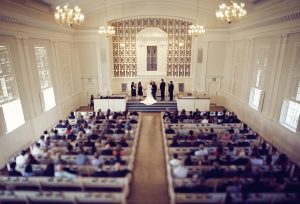
(Lightstock)
The Survey Center on American Life of the American Enterprise Institute reports: “Only 30% of Americans who were married within the past decade report having their ceremony in a church, house of worship, or other religious location and officiated by a religious leader. In stark contrast, more than seven in 10 (72%) Americans who were married at least 40 years ago report having an entirely religious service — at a religious location and with a religious leader presiding. Nearly half (49%) of marriages that took place within the past decade were secular services.”
Rudnick, the New York state pastor, explained: “More weddings are done by friends who got ordained online — even my church members are doing them for friends and family at venues.”
The internet is filled with tutorial articles with headlines such as “How to Perform and Officiate a Wedding Ceremony.”
One of the drivers for this trend — although certainly not the only driver — is the increasing secularization of America.
The Survey Center on American Life reports: “The number of Americans who are religiously unaffiliated has increased nearly sixfold over the past three decades, and Christian identity has plummeted. The number of Americans belonging to non-Christian traditions, while modest in comparison, has risen dramatically. These changes have profoundly affected the religious character of American marriages.”
One of those practical changes is that more couples come from different faith traditions — if from a faith tradition at all.
“Fifty years ago, same-faith marriages dominated the religious landscape. Over eight in 10 (81%) couples married before 1972 share the same religious affiliation with their spouse,” the Survey Center notes. “More recent marriages reveal a distinctly different pattern. Among Americans married in the past decade, just over half (52%) are among couples who belong to the same religious tradition. More recent marriages are also far more likely to be among couples who are both secular. Only 3% of couples married before 1972 are in secular marriages, compared to 16% of couples married in the past decade.”
Mustain, the chaplain and wedding officiant in Dallas, confirms these trends: “About 80% of couples I work with would consider themselves to be spiritual but not religious. While they may practice spirituality on their own, they believe their faith tradition they grew up in no longer resonates with the people they are and views they hold today.”
The reception has become more the center of attention than the ceremony
As attested by the facts already given here, weddings these days are much more about the party than actually tying the knot. A typical, traditional wedding ceremony lasts about 20 minutes, sometimes 30. Receptions last for hours.
“A typical, traditional wedding ceremony lasts about 20 minutes, sometimes 30. Receptions last for hours.”
That’s not to mention all the events that precede the wedding, from showers to brunches to bridal party trips to the rehearsal dinner and more. The wedding ceremony may be the hub of the wheel, but the spokes radiating from it are what turn the wedding industry the most.
According to The Knot, a typical American wedding today employs an average of 14 vendors, from dress shops to photographers, caterers and event planners. Today, 40% of weddings feature a custom cocktail at the reception.
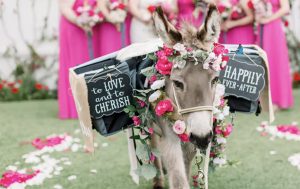
Beer burro photo courtesy of Haul-N-Ass Productions (https://haulnassproductions.com)
And have you heard of beer burros? The website for a Texas company advertises: “Weddings are our specialty, and our minis would love to be a part of your big day. Surprise your guests as they arrive, serve and entertain your guests during rehearsal dinner, cocktail hour, or reception. Or end the evening with a super cute surprise. The minis can hold your favors and late-night snacks too. Plus, these sweet boys not only make excellent servers, they are adorable selfie stations too.”
“Minis” are small burros — little donkeys.
For 16 years, Charles Qualls served as associate pastor at Second-Ponce de Leon Baptist Church in the Buckhead section of Atlanta. In those years — well before the pandemic — he officiated more than 200 weddings.
“A Buckhead wedding was desirable in combination with all the high-profile restaurants and venues nearby,” he explained. “Occasionally, I officiated weddings where the couple were spending well north of $50,000. I can recall one at the Four Seasons Hotel in Midtown. We were in a ballroom that had a ‘winter wonderland’ recreated, with multiple frosted trees and all manner of decor. They had a hired wedding planner and two buses that hauled the entire wedding party from weekend event to event.”
Kathleen Collins Olivieri is a digital content creator in Mississippi. And even she is weary of the Instagram influence on modern weddings.

A photographer takes a picture of a newlywed couple on a piece of rock in Norway called The Troll’s Tongue (123rf.com)
“The wedding industry is the way it is today because of Instagram and Facebook,” she said. “It’s not about the actual experience, it’s about what is posted on social media. The photographer is the most important person at the wedding. If you have a wedding but don’t put it on social media, did it really happen?
Also, “the same pictures are a must: detail shots, bridesmaids in robes and getting married outside or at a venue. I miss the local church — and the savings of at least $10,000 because the wedding took place at a church.”
One pastor — who probably shouldn’t be named along with this story — explained how one lavish wedding often begets an even more lavish wedding because of local expectations.
“I remember one summer with weddings for the daughters of three prominent church families,” the pastor said. “The first looked like the entire florist’s cooler had been emptied. Not to be outdone, the second decorated the ends of every pew in the sanctuary. When it came time for the third, there was so much greenery in the choir loft, the soloist could not get through the door.”
The cost for an average wedding has skyrocketed, and not only because of inflation
The definitive source for the real cost of weddings is the The Knot. There, we learn the latest survey of couples married in 2022 shows the average cost of their weddings was $30,000. That’s just the cost of the ceremony and reception, not including the engagement ring, which The Knot says costs $6,000 on average. Not to mention a honeymoon and all the parties leading up to the wedding.
For $30,000, you could buy a brand-new Subaru Outback. Or make a down payment on a house.
The “good news,” according to The Knot, is that weddings have remained relatively stable in recent years when adjusted for inflation. But the bad news is inflation. Last year’s $30,000 average was an increase of $2,000 over the previous year.
“One of the biggest factors in wedding costs is location, location, location.”
One of the biggest factors in wedding costs is location, location, location.
Not just the choice of venues but the geographic location of the nuptials. It is far cheaper to throw a grand wedding in Wyoming than in Washington, D.C. — an average of $23,000 versus $40,000.

(123rf.com)
Planning a destination wedding? Add at least $6,000 to the tab.
By the way, the cost of a wedding is fairly consistent whether it’s a heterosexual couple or a same-sex couple. A 2016 study found an interesting exception, though, female couples were spending thousands of dollars less than male couples or male-female couples.
Another major factor in wedding costs is how many guests are invited. Back in 1985, we invited everybody we knew to attend our wedding. The cost differential for cake and punch wasn’t that much, whether we had 50 people or 250 people.
But today, every person attending the wedding adds significantly to the total tab. That’s largely due to the trend of serving full sit-down meals at the reception. It’s highly likely the couple will spend more to feed and entertain you at the reception than you spent on a wedding present for them. At $50 to $100 a plate and more (the current average is $75), every person who attends the wedding comes at a cost.
The result is that couples — and their parents — often are forced to make hard decisions about who gets an invitation. If they’ve budgeted for 100 people at the wedding but the combined list of guests is 200, something’s got to give. Coworkers, neighbors and church friends often get left out for economic reasons.
In 2022, the average wedding was attended by 117 guests, up from 105 guests the year before but well lower than the pre-COVID guest count of 131.

(123rf.com)
Where does all the money go for a modern wedding? According to The Knot, these are the current average allocations for some of the items:
- Reception venue: $11,200
- Wedding photographer: $2,600
- Wedding planner: $1,900
- Live band: $3,900
- Reception DJ: $1,500
- Florist: $2,400
- Videographer: $2,100
- Wedding dress: $1,900
- Wedding cake: $510
- Rehearsal dinner: $2,400
Back a few years ago when one of our sons played at that $900,000 wedding in the Colorado Rockies, I got curious about the relationship between how much a wedding costs and how long the marriage lasts.
Turns out, I wasn’t the only one curious about this. There’s actual academic research on this question. And the answer is not what the Wedding Industrial Complex wants you to think: There is an inverse relationship between an expensive wedding and a long-lasting marriage. That means expensive weddings are less likely to launch successful marriages than more economical weddings.
Yet the pressure persists. One friend who spoke to me for this article but didn’t want to be named had just paid for half of the $70,000 bill for the wedding of a daughter. It was a beautiful ceremony (I saw the stunning photos on Facebook) and, as my friend explained, “She’s our only daughter.”
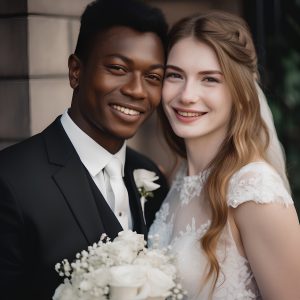
(123rf.com)
My friend is both a loving parent and an accountant by profession, thus the tension.
One of the unspoken factors in wedding costs is assessing what any couple or family can afford.
Qualls, who now serves as pastor at Franklin Baptist in Franklin, Va., says he advises couples during premarital counseling: “Have the wedding you can survive and the wedding you can afford. There’s nothing sadder than a couple out on a beach in Cancun, laying there on their honeymoon worrying about how they’re going to pay for their wedding.”
There are some countervailing forces
Nathan Dove, a wedding photographer in Chapel Hill, N.C., sees a trend toward simplicity in counterbalance to the excesses.
“There’s a big trend in the industry to move toward elopements and micro-weddings,” he said. “Of the dozen weddings I will photograph this year, one is in a church. A lot of the couples I work with spend money on photos, venue, florals, DJ and coordinator. A lot of couples who elope forego the coordinator and the venue altogether.”
This simplicity has an appeal, especially to ministers.
“I recently attended the best and most meaningful wedding I have ever attended: on the lawn after church with food brought by friends in the fellowship hall. I’m ready for us to go back to that,” said Mary Elizabeth Hanchey, an associate pastor at a United Church of Christ congregation in Chapel Hill.
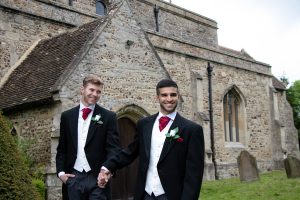
(123rf.com)
Annette Hill Briggs, a pastor in Indiana, said her favorite wedding of recent years “was a couple who did not want to spend that kind of money. They had a church wedding with a church reception prepared by church women. It was lovely and sweet. The fellowship was wonderful. And people really were truly impressed by their decision to do that in such a simple way that focused on the people there. I loved it and wish everyone would do that kind of thing.”
Lamar Wadsworth is a wedding officiant in Rockmart, Ga. Like other ministers, he definitely favors the simpler wedding ceremonies.
“One of the most delightful weddings I ever did was for a young couple who didn’t have a lot of money to spend on a lavish wedding. People in the church, family and friends pulled it all together,” he explained. “All the bridesmaids wore dresses from other weddings they’d been in, a cacophony of different colors. People decorated the little country church with flowers from their yards and flower beds. A friend baked the wedding cake. If you can picture the usual country church homecoming spread with a less-than-perfect wedding cake in the middle of the table, you’ve got the picture. And the pictures were just snapshots from the cameras of family and friends.”
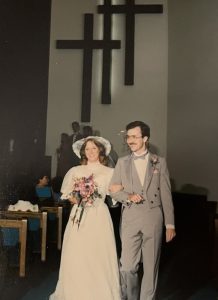
Alison and Mark Wingfield walking out of Sandia Baptist Church in Albuquerque, N.M., in 1985.
Mark Wingfield serves as executive director and publisher of Baptist News Global. He and his wife, Alison, were married in 1985 at Sandia Baptist Church in Albuquerque, N.M. They met on the sidewalk outside the Baptist Student Union at the University of New Mexico three years earlier.
Related articles:
Opting for non-church weddings crosses age, religious categories
COVID has tied the wedding business in knots
When the bride chooses Song of Solomon | Opinion by Brett Younger

